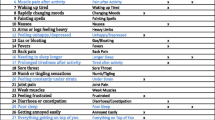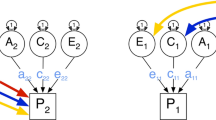Abstract
Self-report symptoms of anxiety are widely used in mental health and social science research as an index of current psychiatric state. Previous twin studies have suggested that genetic factors account for a significant proportion of the variance in these symptoms. To replicate and extend these findings, we examined self-report symtoms of panic-phobia and somatization in the “Virginia 30,000” twin-family sample. Model fitting applied to 80 unique relationships in the twin-family pedigree produced the following major results: (i) genetic effects were significant for both symptom factors, accounting for between 25 and 49% of the total variance, with the exception of symptoms of panic-phobia in females, where they accounted for 15–16% of the variance; (ii) familial environmental effects were absent for symptoms of somatization, while for symptoms of panic-phobia they accounted for a very small proportion of variance in males (≤1.2%) and a modest proportion in females (6–17%) (iii) spousal correlations were present for both factors, ranging from +0.05 to +0.20; (iv) genetic factors which influenced symptoms were generally the same in males and females, although their effect was greater in males; (v) heritability estimates were lower in the population-based than in the volunteer sample; and (vi) when test-retest reliability was included in the model, results suggest that genetic factors account for at least half of the stable variance for all symptom factors, except panic-phobia in females. Our results support the validity of previous twin studies of self-report symptoms of anxiety and suggest that genetic factors significantly influence these symptoms but familial-environmental factors play little or no etiologic role.
Similar content being viewed by others
References
Akaike, H. (1987). Factor analysis and AIC.Psychometrika 52:317–332.
Andrews, G., Tennant, C., Hewson, D. M. and Vaillant, G. E. (1978). Life event stress, social support, coping style, and risk of psychological impairment.J. Nerv. Ment. Dis. 166:307–316.
Bedford, A., Foulds, G. A., and Sheffield, B. F. (1976). A new personal disturbance scale (DSSI/sAD).Br. J. Social Clin. Psychol. 15:387–394.
Clifford, C. A., Hopper, J. L., Fulker, D., and Murray, R. M. (1984). A genetic and environmental analysis of a twin family study of alcohol use, anxiety, and depression.Genet. Epidemiol. 1:63–79.
Crown, S., and Crisp, A. H. (1966). A short clinical diagnostic self-rating scale for psychoneurotic patients. The Middlesex Hospital Questionnaire.Br. J. Psychiatry,112:917–922.
Derogatis, L. R., Serio, J. C., and Cleary P. A. (1972). An empirical comparison of three indices of factorial similarity.Psychol. Rep. 30:791–804.
Derogatis, L. R., Lipman, R. S., and Covi, L. (1973). SCL-90 — An outpatient, psychiatric rating scale-Preliminary report.Psychopharmacol. Bull. 9:13–25.
Duncan-Jones, P., Fergusson, D. M., Ormel, J., and Horwood, L. J. (1990). A model of stability and change in minor psychiatric symptoms: Results from three longitudinal studies.Psychol. Med. Monogr. Suppl. 18.
Eaton, W. W. (1978). Life events, social supports, and psychiatric symptoms: A reanalysis of the New Haven data.J. Health Soc. Behav. 19:230–234.
Eaves, L. J. (1972). Computer simulation of sample size and experimental design in human psychogenetics.Psychol. Bull. 77:144–152.
Eaves, L. J. (1977). Inferring the causes of human variation.J. Roy. Stat. Soc. Ser. A (Gen.) 140:324–355.
Eaves, L. J., Heath, A. C., and Martin, N. G. (1984). A note on the generalized effects of assortative mating.Behav. Genet. 14:371–376.
Eaves, L. J., Long, J., and Heath, A. C. (1986). A theory of developmental change in quantitative phenotypes applied to cognitive development.Behav. Genet. 16:143–162.
Eaves, L. J., Eysenck, H. J., Martin, N. G.,et al. (1989).Genes, Culture and Personality: An Empirical Approach, Oxford University Press, London.
Feild, H. S., and Armenakis, A. A. (1974). On use of multiple tests of significance in psychological research.Psychol. Rep. 35:427–431.
Goldberg, D. (1978).Manual of the General Health Questionnaire. NFER, Windsor, England.
Goldberg, D. P., Bridges, K., Duncan-Jones, P., and Grayson, D. (1987). Dimensions of neuroses, seen in primary-care settings.Psychol. Med. 17:461–470.
Heath, A. C. (1987). The analysis of marital interaction in cross-sectional twin data.Acta Genet. Med. Gemellol. 36: 41–49.
Heath, A. C., and Eaves, L. J. (1985). Resolving the effects of phenotype and social background on mate selection.Behav. Genet. 15:15–30.
Heath, A. C., Kendler, K. S., Eaves, L. J., and Markell, D. (1985). The resolution of cultural and biological inheritance: Informativeness of different relationships.Behav. Genet. 15:439–465.
Jardine, R., Martin, N. G., and Henderson, A. S. (1984). Genetic covariation between neuroticism and the symptoms of anxiety and depression.Genet. Epidemiol. 1:89–107.
Kendler, K. S., Heath, A. C., Martin, N. G., and Eaves, L. J. (1986). Symptoms of anxiety and depression in a volunteer twin population: The etiologic role of genetic and environmental factors.Arch. Gen. Psychiat. 43:213–221.
Kendler, K. S., Neale, M. C., Kessler, R. C., Heath, A. C., and Eaves, L. J. (1992a). A population based twin study of major depression in women: The impact of varying definitions of illness.Arch. Gen. Psychiat. 49:257–266.
Kendler, K. S., Neale, M. C., Kessler, R. C., Heath, A. C., and Eaves, L. J. (1992b). Generalized anxiety disorder in women: A population based twin study.Arch. Gen. Psychiatry 49:267–272.
Kendler, K. S., Walters, E. E., Truett, K. R., Heath, A. C., Neale, M. C., Martin, N. G., and Eaves, L. J. (1994). The sources of individual differences in depressive symptoms: An analysis of two twin-family samples.Am. J. Psychiat. 151:1605–1614.
Lipman, R. S., Covi, L. and Shapiro, A. K. (1979). The Hopkins Symptom Checklist (HSCL): Factors derived from the HSCL-90.J. Affect. Disord. 1:9–24.
Loehlin, J. C., and Nichols, R. C. (1976).Heredity, Environment and Personality: A Study of 850 Sets of Twins, University of Texas Press, Austin.
Lykken, D. T., Tellegen, A., and DeRubies, R. (1978). Volunteer bias in twin research: The rule of two thirds.Soc. Biol. 25:1–9.
MacKinnon, A. J., Henderson, A. S., and Andrews, G. (1990). Genetic and environmental determinants of the lability of trait neuroticism and the symptoms of anxiety and depression.Psychol. Med. 20:581–590.
Martin, N. G., and Wilson, S. R. (1982). Bias in the estimation of heritability from truncated samples of twins.Behav. Genet. 12:467–472.
Martin, N. G., Eaves, L. J., Kearsey, M. J., and Davies, P. (1978). The power of the classical twin study.Heredity 40:97–116.
Martin, N. G., Jardine, R., Andrews, G., and Heath, A. C. (1988). Anxiety disorders and neuroticism: Are there genetic factors specific to panic?Acta Psychiat. Scand. 77: 698–706.
Mather, K., and Jinks, J. L. (1982).Biometrical Genetics: The Study of Continuous Variation, 3rd ed., Chapman & Hall, London.
McGue, R., Wette, R., and Rao, D. C. (1984). Evaluation of path analysis through computer simulation: Effects of incorrectly assuming independent distribution of familial correlations.Genet. Epidemiol. 1:255–269.
Neale, M. C., Eaves, L. J., Kendler, K. S., and Hewitt, J. K. (1989). Bias in correlations from selected samples of relatives: The effects of soft selection.Behav. Genet. 19: 163–169.
Neale, M. C., Eaves, L. J., and Kendler, K. S. (1994). The power of the classical twin study to resolve variation in threshold traits.Behav. Genet. 24:239–258.
Numerical Algorithms Group (NAG) (1978).Fortran Library Manual. Mark 7, NAG, Oxford.
Parker, G. (1981). Parental representations of patients with anxiety neurosis.Acta Psychiat. Scand. 63:33–36.
Plomin, R., and Daniels, D. (1987). Why are children in the same family so different from each other?Behav. Brain Sci. 10:44–54.
SAS Institute (1985).SAS User's Guide: Statistics, Version 5, SAS Institute, Inc, Cary, NC.
Snedecor, G. W., and Cochran, W. G. (1980).Statistical Methods, 7th ed., Iowa State University Press, Ames.
Truett, K. R., Eaves, L. J., Walters, E. E., Heath, A. C., Hewitt, J. K., Meyer, J. M., Silberg, J., Neale, M. C., Martin, N. G., and Kendler, K. S. (1994). A model system for analysis of family resemblance in extended kinships of twins.Behav. Genet. 24:35–49.
Turner, R. J., and Noh, S. (1983). Class and psychological vulnerability among women: The significance of social support and personal control.J. Health Soc. Behav. 24: 2–15.
Vingerhoets, A. J. M., and Van Heck, G. L. (1990). Gender, coping and psychosomatic symptoms.Psychol. Med. 20: 125–135.
Wetherall, D. J., and Clegg, J. B. (1981).The, Thalassemia Syndromes, 3rd ed., Blackwell Scientific, Oxford.
Williams, A. W., Ware, J. E., Jr., and Donald, C. A. (1981). A model of mental health, life events, and social supports applicable to general populations.J. Health Soc. Behav. 22:324–336.
Author information
Authors and Affiliations
Corresponding author
Rights and permissions
About this article
Cite this article
Kendler, K.S., Walters, E.E., Truett, K.R. et al. A twin-family study of self-report symptoms of panic-phobia and somatization. Behav Genet 25, 499–515 (1995). https://doi.org/10.1007/BF02327574
Received:
Accepted:
Issue Date:
DOI: https://doi.org/10.1007/BF02327574




